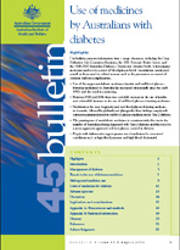Summary
This bulletin presents information from a range of sources, including the Drug Utilisation Sub-Committee Database, the 2001 National Health Survey and the 1999–2000 Australian Diabetes, Obesity and Lifestyle Study. It investigates medicines used in the control of blood glucose levels (‘antidiabetic medicines’) as well as those used for related reasons such as the prevention or control of common diabetes complications.
- Use of the major antidiabetic medicines (insulin and oral blood glucose–lowering medicines) in Australia has increased substantially since the early 1990s and the trend is continuing.
- Between 1990 and 2004 there was a twofold increase in the use of insulin and a threefold increase in the use of oral blood glucose–lowering medicines.
- Metformin is the most frequently used oral blood glucose–lowering medicine in Australia, followed by gliclazide and glimepiride; these findings comply with current recommendations for oral blood glucose medicine use in Type 2 diabetes.
- The growing use of antidiabetic medicines is consistent with the rise in the number of Australians being diagnosed with Type 2 diabetes and the trend to a more aggressive approach to blood glucose control in diabetes.
- People with diabetes also report greater use of medicines for associated conditions such as high blood pressure and high blood cholesterol.



